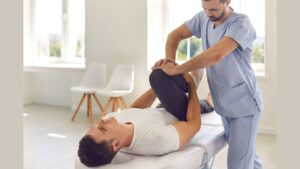Exploring the Role of Physiotherapy in Stroke Rehabilitation
Introduction:
Stroke is a significant health concern globally, often leaving survivors with long-term disabilities affecting their mobility and independence. However, with advancements in medical science and rehabilitation techniques, the outlook for stroke survivors has improved considerably. Physiotherapy plays a pivotal role in stroke rehabilitation, focusing on restoring movement, enhancing function, and improving the overall quality of life for affected individuals.
Understanding Stroke Rehabilitation:

Understanding Stroke Rehabilitation
Stroke rehabilitation is a comprehensive process aimed at helping stroke survivors regain lost abilities and adapt to any permanent disabilities. Physiotherapy, along with other disciplines such as occupational therapy and speech therapy, forms an integral part of this rehabilitation journey. The primary goal of physiotherapy in stroke rehabilitation is to maximize physical function and mobility while minimizing complications.
Early Intervention and Assessment:
Early intervention is crucial in stroke rehabilitation to initiate treatment promptly and prevent further deterioration. Physiotherapists conduct thorough assessments to evaluate the extent of impairments and tailor rehabilitation plans accordingly. These assessments may include testing muscle strength, range of motion, balance, coordination, and functional abilities.
Customized Treatment Plans:
Physiotherapy interventions in stroke rehabilitation are highly individualized, considering the unique needs and goals of each patient. Treatment plans may include a combination of exercises, manual therapy techniques, and modalities such as electrical stimulation or hydrotherapy. These interventions aim to improve muscle strength, flexibility, balance, and gait, ultimately promoting independence in activities of daily living.
Gait Training and Mobility:
One of the primary focuses of physiotherapy in stroke rehabilitation is gait training. Stroke survivors often experience difficulties with walking due to muscle weakness, spasticity, or coordination problems. Physiotherapists employ various strategies such as treadmill training, balance exercises, and assistive devices to enhance gait patterns and improve overall mobility.
Functional Rehabilitation:
In addition to addressing physical impairments, physiotherapy also emphasizes functional rehabilitation. This involves practicing real-life activities such as dressing, bathing, and household chores to promote independence and confidence. Through repetitive task-oriented training, stroke survivors can relearn essential skills and regain autonomy in daily life.
Education and Support:
Physiotherapists play a vital role in educating both stroke survivors and their caregivers about the rehabilitation process and self-management strategies. They provide guidance on safe techniques for movement and activities, as well as tips for preventing complications such as falls or secondary musculoskeletal issues. Emotional support and encouragement are also integral components of physiotherapy care, helping individuals cope with the challenges of recovery.
Long-Term Management:
Stroke rehabilitation is often a long-term journey, requiring ongoing support and monitoring. Physiotherapists collaborate with other healthcare professionals and community resources to ensure continuity of care beyond the acute phase. They may assist in transitioning stroke survivors back to home or community settings and provide recommendations for maintenance exercises and follow-up assessments to optimize long-term outcomes.
Conclusion:
Physiotherapy plays a vital role in stroke rehabilitation, helping individuals recover physical function, regain independence, and improve their overall quality of life. Through personalized treatment plans, focused interventions, and ongoing support, physiotherapists empower stroke survivors to overcome challenges and achieve their rehabilitation goals. With continued advancements in rehabilitation techniques and a multidisciplinary approach, the outlook for stroke survivors continues to improve, offering hope for a brighter future post-stroke.


Leave a Reply